By Zach Cunningham
Assistant Coach
Spring Valley High School (NV)
Twitter: @CoachCunny
Introduction
An attacking defense is one of the toughest things to game plan for and play against. Bringing heat and blitzing a flustered quarterback makes everybody’s job not only easier, but more fun. We all know that a well-executed screen can not only neutralize a blitz package but make the defense extremely cautious throughout the (rest of the) game. We play a 3-4 defense which means we like to bring heat, a lot. We will still bring 5-man blitzes vs teams that have an effective screen game by using our “Keeper/Creeper” concept. This philosophy works whether we are in man or zone in the secondary.
Alignment: For the purposes of this article, I will introduce our “Keeper/Creeper” concept versus a 2x2 formation. In our base 3-4, our DEs are in a tight 5-technique alignment. Mike and Will are basically in a 40-I technique and our Leo and Robber are set at 3x5 off the tackle depending on the width of the #2 WR (Diagram 1).

Importance of the Back
We use two main blitz packages in our 3-4 defense. Each of these can adapt into multiple variations. The RB alignment will dictate which linebacker is involved in the blitz in our Ambush and Crash blitz concepts.

The RB is the key to our pressure game. We can call the blitz however we want (i.e. strength, field, back, etc) but the players need to know how to adjust based on the alignment of the back. In every blitz we have what we call a “Keeper” and a “Creeper”.
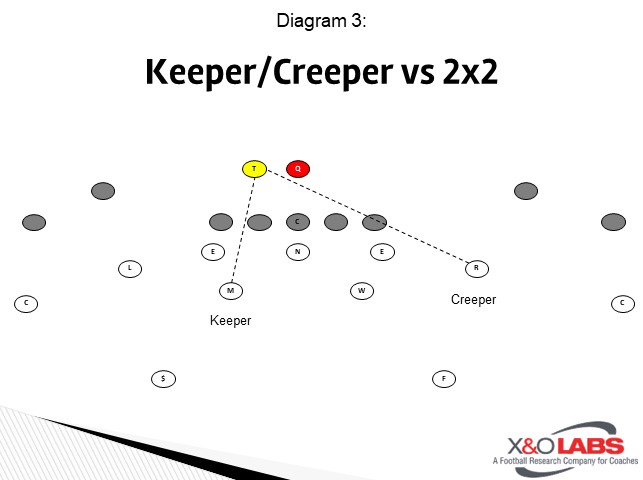
These two players need to know on every play who is the Keeper and who is the Creeper. The ILB tagged as the Keeper will never blitz. The OLB tagged as the Creeper will still go if he is involved in the call, but he will blitz with caution.
Ambush Blitz
We like to call our Ambush blitz to the strength which against 2x2 would be to the RB (Diagram 4). The Keeper is the Mike called into the blitz and the Creeper is the Robber. The adjustment made is that the Mike will then pass his blitz off to the Will. The Robber is still the Creeper even though he is not called into the blitz (Diagram 5). We still get our 5-man pressure but are not susceptible to the RB screen to a certain side.


If we call an Ambush Weak against the same look, the Keeper & Creeper rules still apply (Diagram 6). The Mike is the Keeper so the Will is free to continue on his blitz.

The Robber is still the Creeper, but he will still go in the call. His technique changes though as he is essentially spying the RB while blitzing. This is done by keeping the proper blitz angle of the upfield shoulder on the QB, but his eyes are tracking the RB’s release. If the RB goes away or stays in to block, the OLB will continue his path to QB. If the RB releases towards him, he will peel off and stay on the back. In doing this we do occasionally lose a blitzer, but it always guarantees us that somebody will be on the RB for screen or any other route he may run.
This system is used in both man coverage and zone coverage. In Man, we run a Cover 0 in the 3-4. This is due to not enough skill guys to cover 4 to 5 receivers and it also simplifies everybody’s job. We will use the same exact Keeper/Creeper rules in both Man and Zone. The last thing we want to do is blitz people out of an open half of the field or be outnumbered to a side in Zone (Diagram 7).
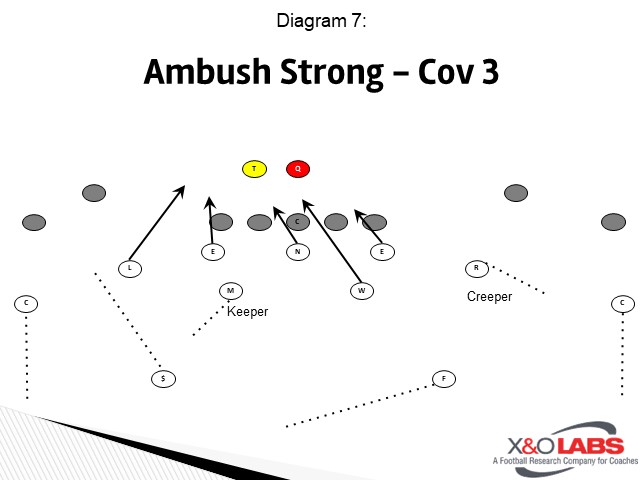
Variations
This concept works against every formation. As you will see, there is always a Keeper and a Creeper in every case.
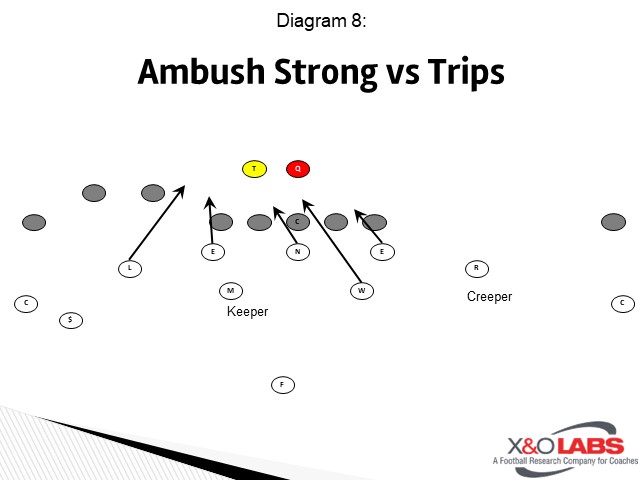
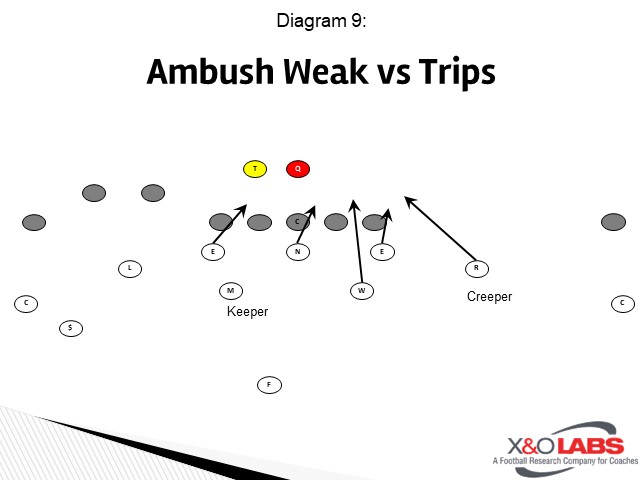
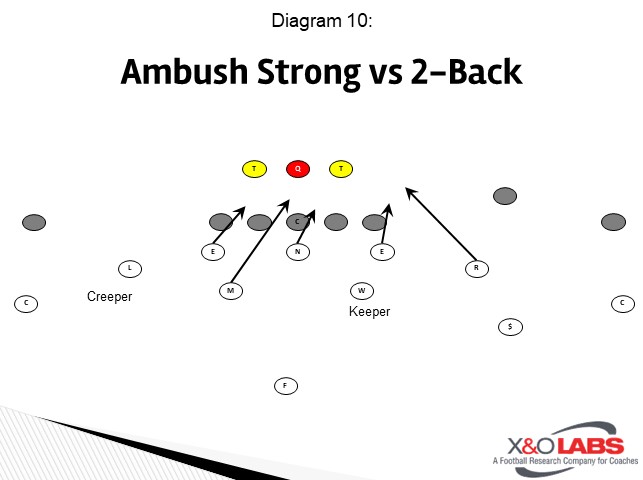

A very common issue that many of us face is the Pistol backfield. One reason offenses do this is, so a defense cannot predicate themselves to the RB. This directly affects our Keeper/Creeper concept. One way we adjust, besides breakdown data, is based on the field and hashes. If the offense is on a hash with a Pistol backfield, we will automatically make the boundary ILB the Keeper and field OLB the Creeper (Diagram 12) The called blitz is still on.
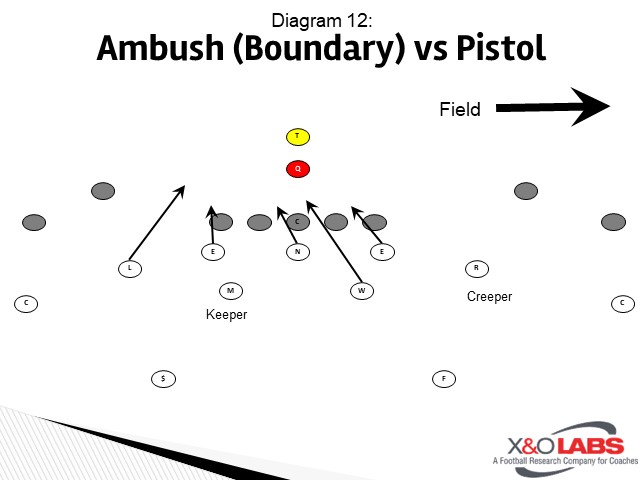
Another variation to this concept is with a different pressure package. We can use the same system when bringing two guys off the edge. This is our Crash blitz (Diagram 13).
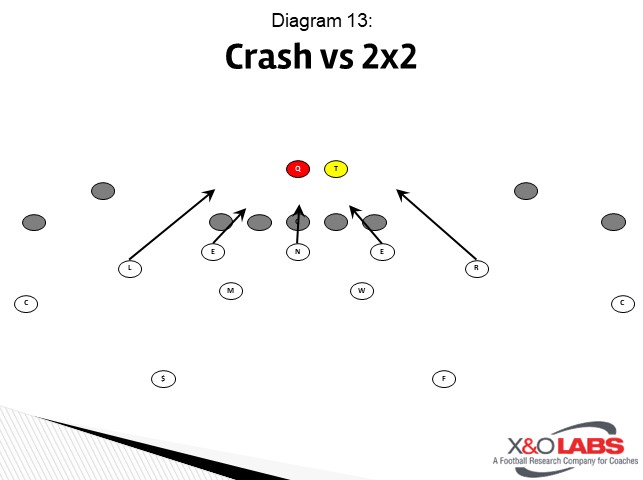
Here you have a couple options on how you want to defend the RB screen. Since you still have both ILB’s free for RB, you can have only them on Keeper responsibility and let the OLB be free to go. The other option is to maintain the same teaching principles
Assistant Coach
Spring Valley High School (NV)
Twitter: @CoachCunny
Introduction
An attacking defense is one of the toughest things to game plan for and play against. Bringing heat and blitzing a flustered quarterback makes everybody’s job not only easier, but more fun. We all know that a well-executed screen can not only neutralize a blitz package but make the defense extremely cautious throughout the (rest of the) game. We play a 3-4 defense which means we like to bring heat, a lot. We will still bring 5-man blitzes vs teams that have an effective screen game by using our “Keeper/Creeper” concept. This philosophy works whether we are in man or zone in the secondary.
Alignment: For the purposes of this article, I will introduce our “Keeper/Creeper” concept versus a 2x2 formation. In our base 3-4, our DEs are in a tight 5-technique alignment. Mike and Will are basically in a 40-I technique and our Leo and Robber are set at 3x5 off the tackle depending on the width of the #2 WR (Diagram 1).

Importance of the Back
We use two main blitz packages in our 3-4 defense. Each of these can adapt into multiple variations. The RB alignment will dictate which linebacker is involved in the blitz in our Ambush and Crash blitz concepts.

The RB is the key to our pressure game. We can call the blitz however we want (i.e. strength, field, back, etc) but the players need to know how to adjust based on the alignment of the back. In every blitz we have what we call a “Keeper” and a “Creeper”.
- Keeper - ILB aligned to the side of the RB
- Creeper - OLB aligned opposite of the RB

These two players need to know on every play who is the Keeper and who is the Creeper. The ILB tagged as the Keeper will never blitz. The OLB tagged as the Creeper will still go if he is involved in the call, but he will blitz with caution.
Ambush Blitz
We like to call our Ambush blitz to the strength which against 2x2 would be to the RB (Diagram 4). The Keeper is the Mike called into the blitz and the Creeper is the Robber. The adjustment made is that the Mike will then pass his blitz off to the Will. The Robber is still the Creeper even though he is not called into the blitz (Diagram 5). We still get our 5-man pressure but are not susceptible to the RB screen to a certain side.


If we call an Ambush Weak against the same look, the Keeper & Creeper rules still apply (Diagram 6). The Mike is the Keeper so the Will is free to continue on his blitz.

The Robber is still the Creeper, but he will still go in the call. His technique changes though as he is essentially spying the RB while blitzing. This is done by keeping the proper blitz angle of the upfield shoulder on the QB, but his eyes are tracking the RB’s release. If the RB goes away or stays in to block, the OLB will continue his path to QB. If the RB releases towards him, he will peel off and stay on the back. In doing this we do occasionally lose a blitzer, but it always guarantees us that somebody will be on the RB for screen or any other route he may run.
This system is used in both man coverage and zone coverage. In Man, we run a Cover 0 in the 3-4. This is due to not enough skill guys to cover 4 to 5 receivers and it also simplifies everybody’s job. We will use the same exact Keeper/Creeper rules in both Man and Zone. The last thing we want to do is blitz people out of an open half of the field or be outnumbered to a side in Zone (Diagram 7).

Variations
This concept works against every formation. As you will see, there is always a Keeper and a Creeper in every case.




A very common issue that many of us face is the Pistol backfield. One reason offenses do this is, so a defense cannot predicate themselves to the RB. This directly affects our Keeper/Creeper concept. One way we adjust, besides breakdown data, is based on the field and hashes. If the offense is on a hash with a Pistol backfield, we will automatically make the boundary ILB the Keeper and field OLB the Creeper (Diagram 12) The called blitz is still on.

Another variation to this concept is with a different pressure package. We can use the same system when bringing two guys off the edge. This is our Crash blitz (Diagram 13).

Here you have a couple options on how you want to defend the RB screen. Since you still have both ILB’s free for RB, you can have only them on Keeper responsibility and let the OLB be free to go. The other option is to maintain the same teaching principles









